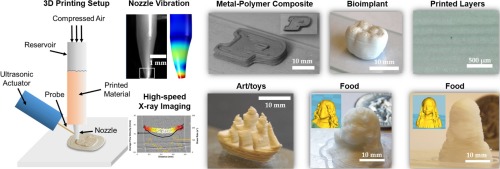Purdue researchers have developed a process which enables them to 3D print notoriously difficult viscous materials. Due to this, they should be able to 3D print everything from cookie dough to biomedical implants.
Researchers at Purdue university’s Zucrow Labs – the largest academic propulsion lab in the world — have applied high-amplitude ultrasonic vibrations to the nozzle of a 3D printer which has resulted in the ability to print viscous materials. Think clay or solid rocket fuel.
The reason this research is so exciting, the Purdue News page points out, is that manufacturers have been attempting to solve this problem for years without any success.
Previously, manufacturers would change a material’s composition to make it more printable. But, by changing the printer, not the material, the researchers found that they could reduce friction on the nozzle walls so a viscous material could “snake” through.
“It’s very exciting that we can print materials with consistencies that no one’s been able to print,” says Emre Gunduz, assistant research professor in the School of Mechanical Engineering. “We can 3D print different textures of food; biomedical implants, like dental crowns made of ceramics, can be customized. Pharmacies can 3D print personalized drugs, so a person only has to take one pill, instead of 10.”
3D Printing Cookies & Rocket Fuel (Not With the Same Printer)
In the lab, they used a Makerbot Replicator 2x and a Monoprice Select Mini for testing. As a result of this research, the team believes it’ll be possible to print a wide range of materials, including, ceramics, pharmaceuticals, biomedical implants, foodstuffs and even solid rockets.
The process also enables researchers to print with 100-micron precision and still maintain high print rates. They add that this is better than a consumer-level 3D printer.
To measure the flow of the materials through the nozzle, the team traveled to Argonne National Laboratory to conduct high-speed microscopic X-ray imaging. By doing this, they were able to see inside the nozzle and understand both how the method was working while quantifying the flow.
The first practical application of this new process is the printing of solid rocket fuel. This material starts out viscous, but is sensitive to temperature and overtime will cure, making it difficult to print.
But, by using their new method, the researchers were able to print two-centimeter samples of solid propellant. They then tested the samples by igniting them in a high-pressure vessel. They found that the samples “burned comparably to traditionally cast methods.”
Want to find out more? The researcher’s work was published in the journal Additive Manufacturing.
Source: Purdue News

License: The text of "Purdue Researchers 3D Print Cookie Dough, Clay and Solid Rocket Fuel" by All3DP is licensed under a Creative Commons Attribution 4.0 International License.